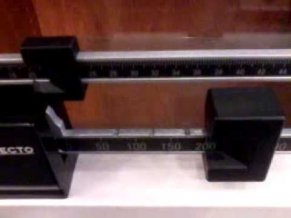How to use weighing scales?

Ensure that the scale is calibrated. When the large counter weight and the small sliding weight are both on zero, the rotating beam should come to a stop where it is completely horizontal and the needle on the far right end is in the center of the slot.
Remove your shoes and any heavy clothing such as a jacket before stepping on the scale. This will give you a more accurate reading for your weight.
Determine an estimate for your weight so that you’ll know a general place for beginning the measurement. For example, if you know you are around 155 pounds you can start the scale there.
Step onto the scale facing the beam. Slide the large counter weight to a number less than, but closest to your estimated weight. For example if you think you weigh about 155 place the counter weight on 150.
Slide the small weight slowly along the scale. You will feel small notches along the scale where the sliders can rest at each weight increment. Watch the balance beam. Once at the correct weight it should come to a stop completely horizontal with the needle in the center of the slot as it did when the scale was at zero.
Adjust the small weight slowly up or down if the beam did not rest horizontally in a straight line. If the estimate was way off you may also need to adjust the large counter weight.
Determine your actual weight once the beam comes to rest in a straight line horizontally. The large counter weight gives you the first part of the number, such as 150, and the small weight gives you the additional amount. For example if it is set on 6 then your weight would be 156.
- If the scale is not calibrated correctly you will need to consult the instruction manual to learn how to accomplish this. Typically a screwdriver or similar item can be used to turn a screw on one side of the beam which will move it up or down and closer to zero as needed.
купить фронтальный погрузчик Пермь
Related posts:
- 300kg weighing scales
- Patient weighing scales
- Analogue weighing scales
- What are weighing scales?
- There are two types of authentication for foreign documents. Georgia apostille. Atlanta apostille.

 One of the more cost-effective measurements in a paper mill is that which monitors the flow of pulp stock into the head box of the paper machine. The stock level…
One of the more cost-effective measurements in a paper mill is that which monitors the flow of pulp stock into the head box of the paper machine. The stock level… Why is taking all the tricks called a boston in pinochle what are kegel exercises How to change administrator on windows 10? In what order should you learn tricks…
Why is taking all the tricks called a boston in pinochle what are kegel exercises How to change administrator on windows 10? In what order should you learn tricks… Overview Marel Marine Scales are specifically designed for use on board fishing vessels and factory trawlers. This cost-effective series of scales ranges from the…
Overview Marel Marine Scales are specifically designed for use on board fishing vessels and factory trawlers. This cost-effective series of scales ranges from the… How long to air fry french fries what does fafsa stand for What does it mean when ypu use alocohol and the tips of your fingers turn white Who raps bitches aint…
How long to air fry french fries what does fafsa stand for What does it mean when ypu use alocohol and the tips of your fingers turn white Who raps bitches aint… Globe s portion control scales can be used in a wide spectrum of applications from delis and pizza parlors, to bakeries and restaurants, or any establishment where…
Globe s portion control scales can be used in a wide spectrum of applications from delis and pizza parlors, to bakeries and restaurants, or any establishment where…